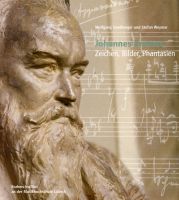Johannes Brahms
Zeichen, Bilder, Phantasien
With the title »Johannes Brahms: Zeichen, Bilder, Phantasien« (»Johannes Brahms: Signs, Images, Fantasies«), the Brahms-Institut presents an overview of its collection grouped into eight sections. On view are precious and often unpublished music manuscripts, photographs, letters, concert programs, and other treasures of the collection, including several engravings from Max Klinger’s Brahms-Phantasie.
Klinger’s series of engravings inspired the show’s title. Just as in Klinger’s engravings, where images, music, and poetry become a fascinating unity, the ensemble of various objects in the exhibition seeks to provide an open picture of Brahms that offers many points of departure for our knowledge about this great composer and our own fantasy.
Background:
Johannes Brahms was not only a man of sound, but also a man of vision, who had a special affinity for museums and exhibitions. The Swiss writer Joseph Victor Widmann, who accompanied Brahms on several trips to Italy, reports as follows: »Brahms quickly walked through the galleries; wherever his step slowed, you could be sure that a genuine work of art hung or something especially original could be viewed there. Then he called the attention of his companion and made him aware of some intimate detail of the painting, but sometimes he just lingered alone in front of the painting, because the revelation of pure, high beauty brought tears to his eyes«.
The objects shown in the Brahms exhibition do not seek to be the »revelation of pure, greater beauty« as in a Titian, Raphael, or Michelangelo, but they are still moving in their own way: a view of the personal address book could be touching for the Brahms lover, just as a view of a Brisé fan with Brahms’ signature, his wallet, pictures collected by the composer in visiting card format or even his letters. Above all, the musical manuscripts of the composer fascinate even the untrained eye. In viewing an original like this, the mysterious moment when a composition is brought to paper comes alive. The writer Stefan Zweig described this moment impressively as the »most mysterious second of transfer, when a verse, a melody, from the invisible, moves from the vision and intuition of a genius to the earthly by way of graphic fixation«. The show also shows previously unpublished sources like the first 2002 autograph of the song »Liebesgluth«, op. 47, No.2, which had been considered lost until then.
Presenting a Music Exhibition:
An exhibition that is primarily about music has its own special laws of presentation. Music is an art that takes place in time. When the sounds have past, they only remain in our memory. Of course, music can also be made legible or visible in scores, concert programs, letters or artworks like Klinger’s Brahms-Phantasie. And yet without the real sound a music exhibition lacks an essential component.
Brahms himself was very aware of that when he visited in 1888 the music exhibition in Bologna together with the aforementioned Joseph Victor Widmann, where precious manuscripts and old instruments were shown. As can be read in Widmann’s memoirs: »One viewed with the same sense of awe that the believing Catholic has while looking at relics, but felt that an art that is entirely for the ear is quite unsuitable for an exhibition for the eye.«
The exhibition concept kept this in mind and responded accordingly. There are four audio stations where the visitor has the opportunity to experience music. This results in a unique situation of visitors being able to listen to the fifth movement of Ein deutsches Requiem and to examine the composer’s manuscript of the piece at the same time. The other listening stations offer a reconstruction of the concert program in which Brahms’ First Symphony was premiered, in addition to precious items and rarities from the pen of Brahms’ friend Theodor Kirchner or of Joseph Joachim.






